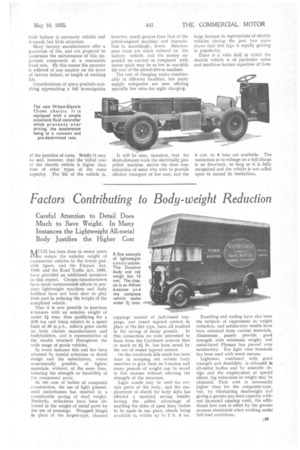Factors Contributing to Body-weight Reduction
Page 107

If you've noticed an error in this article please click here to report it so we can fix it.
Careful Attention to Detail Does Much to Save Weight. In Many Instances the Lightweight All-metal Body Justifies the Higher Cost
SUCH has been done in recent years IVito reduce the unladen weight . of commercial vehicles_ to the lowest possible figure; and the Finance Act, 1933, and the Road Traffic Act, 1930, have provided an additional incentive in this respect. Chassis manufacturers have made commendable efforts to produce lightweight machines and body builders have not been slow to play their part in reducing the weight of the completed vehicle.
That it is now possible to purchase 4-tonners with an unladen weight of under 2i tons, thus qualifying for a £30 tax and being subject to a speed limit of 30 m.p.h., reflects great credit on both chassis manufarturers and bodybuilders, and is representative of the results obtained throughout the wide range of goods vehicles.
In every instance this end has been attained by careful attention to detail design and the substitution, where economically possible, of lighter materials, without, at the same time, reducing the strength or durability of the component parts.
In the case of bodies of composite construction, the use of light pressedsteel underframes has resulted in a considerable saving of dead Weight. Similarly, reductions have been obtained in the weight of metal parts by the use of pressings. Wrapped hinges in place of the forged-type, channel
cappings instead of ,half-round cappings, and round tapered cotters in place of the flat type, have all resulted in the saving of many pounds. In this connection we were interested to learn from the Carrirnore concern that as much as 51 lb. baS been saved by the use of round tapered cotters.
On the woodwork side much has been done in scooping out certain body members to give them an I-section and many pounds of weight can be saved in this manner without affecting the strength of the structure.
Light woods may be used for certain parts of the body, and the employment of obechi for body sides has effected a material saving besides having the added advantage of enabling the sides of open lorry bodies to be made in one piece, obechi being available in widths up to 2 ft. fi ins. Panelling and roofing have also been the subjects of experiment in weight reduction, and satisfactory results have been obtained from various materials. Aluminium panels provide good strength with minimum weight, and metal-faced Plymax has proved very satisfactory. For light vans Suncleala has been used with much success,
Lightness, combined with great strength and durability, is obtained in all-metal bodies and by scientific design and the employment of special alloys, big reductions in weight may be obtained. First cost is necessarily higher than for the composite-type, hut, by eliminating deadweight and giving a greater pay-load capacity without increased running costs, the additional first cost is offset by the greater revenue obtainable when working under full-load conditions.




































































































































































